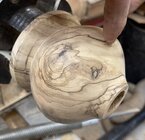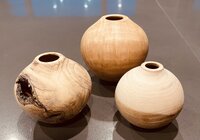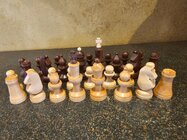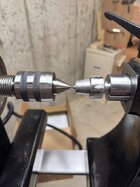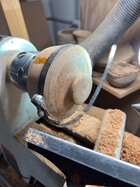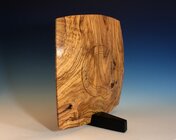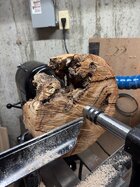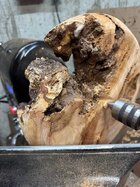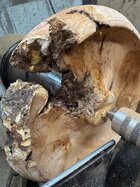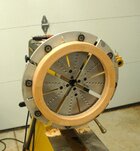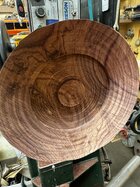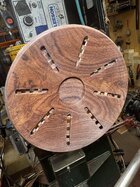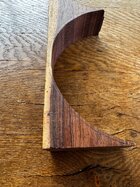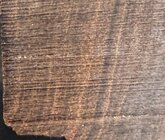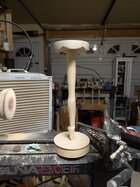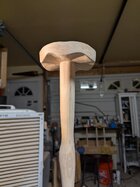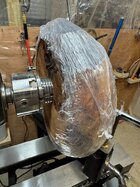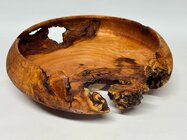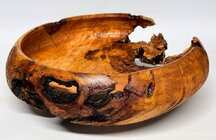-
April 2025 Turning Challenge: Turn an Egg! (click here for details) -
Congratulations to Kelly Shaw winner of the March 2025 Turning Challenge (click here for details) -
Congratulations to Guillaume Fontaine for "Nebules" being selected as Turning of the Week for April 6, 2025 (click here for details) -
Welcome new registering member. Your username must be your real First and Last name (for example: John Doe). "Screen names" and "handles" are not allowed and your registration will be deleted if you don't use your real name. Also, do not use all caps nor all lower case.
You are using an out of date browser. It may not display this or other websites correctly.
You should upgrade or use an alternative browser.
You should upgrade or use an alternative browser.
What’s on your lathe?
- Thread starter Rusty Nesmith
- Start date
Really cool. Do you make your own pewa? Never seen them in persimmon.Redbud. Maple and persimmon pewas
Nice piece of Olive Alan! You may now see why I like to turn it, great smell and it cuts really nice!well, not my lathe, but Mike Jackofsky’s. I’m doing a two day course with him, one on one.View attachment 74552He’s a brilliant turner. Here’s an olive (damn, is that hard wood) piece I’m working on now.
And here’s a eucalyptus piece I finished there. View attachment 74553
Olive is one of my favorites too - fine grain, I love the look with oil. I think this is a test with naphtha before reversing and turning the top:Nice piece of Olive Alan! You may now see why I like to turn it, great smell and it cuts really nice!
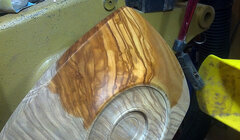
I got a wide slab once from a friend (never saw an Olive tree that large), brought some back from Italy, and have purchased a lot over the years. I often use it for kitchen things my Lovely Bride requests.
JKJ
Came out nice—on the left—no finish on any. The pecan piece on right has an opening under 3/4 inch, my smallest yet.
View attachment 74571
Those look great, Alan.
A friend brought over some lilic branches and a few root balls. I need to cleanup the root balls a bit before I see if I can make something from them. I did get started on turning the branches. I know others have turned similar, but I made a few of these several years ago with a class with Rudy Lopez. I probably should look for the handout or notes from that class as I'm not sure if I am doing it the same. The first try the pith was too close to the center and I wasn't able to make the stem before it broke. The pith on lilic isn't solid at all. This one is 6" or so and I took a few process pic's as I wasn't sure I could complete it.
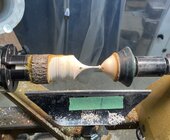
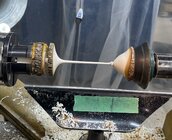




A friend brought over some lilic branches and a few root balls. I need to cleanup the root balls a bit before I see if I can make something from them.
Nice goblet! Good use for the cone attachment.
I don’t know about lilac root balls (if the roots you mentioned are lilac), but for those not familiar with turning roots and root balls note the possibility of embedded rocks. I’ve turned some manzanita root balls and in addition to the dirt there were some rocks inside the root grew around. A pressure washer is nice to clean away the dirt and stuff on the outside but I don’t know what to do about totally embedded rocks! Be prepared to sharpen, I guess.
BTW, when “harvesting” big roots a chainsaw with a carbide chain helps if digging down and the hole is too tight to swing an axe. (these days I use the excavator.
Hey, look at the figure (bottom and middle photos) on the small vase I turned from rhododendron root. The roots were not large but well worth digging.
(Sorry, the photos are from long ago and poor)
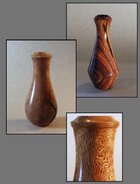
JKJ
Started to turn another piece of cherry making lidded bowl
First the base split apart at a fault in the wood so I glued it together with titebond glue .
Then the lid did the same I glued that together and held together with I band
Hoping I will be able to salvage it !
First the base split apart at a fault in the wood so I glued it together with titebond glue .
Then the lid did the same I glued that together and held together with I band
Hoping I will be able to salvage it !
Attachments
Nice threads is that home made jig or the chef wares version?Did somebody say acorn boxes? It's time to make a few. This one is a pear bottom with black walnut top.
View attachment 74537
View attachment 74538
View attachment 74539
Yes. Thanks to guidance from Ed Pretty https://www.woodworkersjournal.com/adding-an-inlaid-butterfly-patch/Really cool. Do you make your own pewa? Never seen them in persimmon.
Sure looks like much more work than using bigisland templates and pewa but a great result!Yes. Thanks to guidance from Ed Pretty https://www.woodworkersjournal.com/adding-an-inlaid-butterfly-patch/
The carving looks like a lot of work! By hand or powered?
And you’ll be turning some of my favorite woods. I especially like sapele - I bought a number of big sapele slabs from a friend a long time ago - Great for platters. These are 14.5 and 19.5”, the only two we kept for the house.
View attachment 74181
Held by recesses left in the bottom.
View attachment 74182
Olive is another favorite. I got a big slab from another friend years ago and still have about 1/2 left. I like to make these:
View attachment 74183
JKJ
John, I enjoy your posts and read them whenever I can. I happen to see the Olivewood platter that you posted and I thought I would share a picture of a similar platter that I turned several years ago. This was a piece of 1 inch olive wood that I had in my shop for years. It was covered with dirt and grime, and I wasn’t sure what to do with it, so it sat under a pile of wood for at least 10 years. I finally decided to make a platter and was astounded by the grain that appeared.
Attachments
Sure looks like much more work than using bigisland templates and pewa but a great result!
Thanks. Actually it was not much work to make the templates. I made three sizes. Indeed there is extra work in making the pewas, but, as you noted, I can make them now out of persimmon or any scrap wood I have on hand. I don't have many long blocks of time to turn but when I have 30 mins on a weeknight I can produce several pewas. One potential time save I found was, instead of using masking tape and hot melt glue when routing the pewas from scrapwood, I simply use double-sided tape.
Olivewood platter
Nice!! Your turning and finishing look fantastic.
I usually do these with 8/4 stock but have made them from more and less. The one from olive shown was from 6/4.
Hey, I just noticed your location - do you know Mike Hunter (Hunter Tools)? Some years ago Mike asked me if I minded if he did demos on my “Small Squarish” design. I said sure, have at it, since Minneapolis was far from anywhere I might demo. (I’ve taught the design and techniques in several clubs in TN and some surrounding states but MN is just too far of a drive.
I sent Mike a set of templates. I made templates from plexiglas from 7.5” up to 10.5”. These dished platters make great wedding and housewarming presents!
JKJ
- Joined
- Nov 27, 2021
- Messages
- 168
- Likes
- 677
- Location
- Silver Spring, MD
- Website
- www.transpirationturning.com
This is also a great use for a small CNC (or laser). I make them with whatever various cut-offs or slabed center cuts I have sitting around. It is quick and easy to make a large supply in whatever wood-type, sizes (and shapes) are required.Thanks. Actually it was not much work to make the templates. I made three sizes. Indeed there is extra work in making the pewas, but, as you noted, I can make them now out of persimmon or any scrap wood I have on hand. I don't have many long blocks of time to turn but when I have 30 mins on a weeknight I can produce several pewas. One potential time save I found was, instead of using masking tape and hot melt glue when routing the pewas from scrapwood, I simply use double-sided tape.
Wrap it.Not sure how far I will make it with this hunk of cherry.
View attachment 74632View attachment 74633View attachment 74634
Not sure how far I will make it with this hunk of cherry.
View attachment 74632View attachment 74633View attachment 74634
That would be a great candidate for acrylic.
Yes, it's the Chef Ware Kits jig.Nice threads is that home made jig or the chef wares version?
We'll see how well this Wenge bowl fairs after it reaches the buffing stage. It's very porous, but sealed internally by 4-5 coats of DO. Most turners would probably use a sanding sealer or other type of filler for such porous grain, but I'm looking to preserve the natural look of the wood.
Wenge turns well, and even though it seemed almost brittle to cut, it did cut well.....which allowed basic initial sanding to start at 180gr.
This bowl blank has been in my inventory for 14 years, and that's because I avoided it. This is because I didn't like the results I got from this wood on my previous attempts. I decided to finish this one off and see if there is anything worthy of satisfaction this time around.
=o=
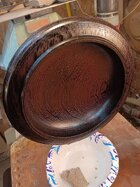
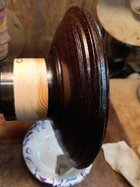
Wenge turns well, and even though it seemed almost brittle to cut, it did cut well.....which allowed basic initial sanding to start at 180gr.
This bowl blank has been in my inventory for 14 years, and that's because I avoided it. This is because I didn't like the results I got from this wood on my previous attempts. I decided to finish this one off and see if there is anything worthy of satisfaction this time around.
=o=


Last edited:
Cocobolo has a very distinctive and I think not unpleasant spicey odor - experience it once and you can't forget. If you can get a small piece of cocobolo from someone and sand or cut it, you will know. Someone in your club probably has some scraps. If you lived nearby I'd give you some. (I have a bunch.)I was given this chunk of wood - thought it might be Cocobolo, but I have never turned that… stopping for dinner…
It's also well known skin and respiratory irritant to many people - a test for sensitivity to various woods is put a bit of sawdust under a bandaid on the inside of the forum and see what itches or develops a rash! It's also a sensitizer - repeated exposure can cause sensitivity to worsen.
If it is cocobolo, don't put oil on it! I applied "danish" to a piece once and it over some months all the color went away and the wood turned black.
JKJ
Last edited:
Good to know! Thanks John.
I understand it is an irritant, so I kept my PAPR on until I had thoroughly taken the air hose to every square inch of me and left the shop. I’ll have to see about a spicy smell when I head back to the shop.
I understand it is an irritant, so I kept my PAPR on until I had thoroughly taken the air hose to every square inch of me and left the shop. I’ll have to see about a spicy smell when I head back to the shop.
Good to know! Thanks John.
I understand it is an irritant, so I kept my PAPR on until I had thoroughly taken the air hose to every square inch of me and left the shop. I’ll have to see about a spicy smell when I head back to the shop.
It’s also a quite heavy wood. Polishes nicely by just buffing. I love working with it. Not long after I started turning I got a number of pieces of outstandingly beautiful wood for a song, for about $50 I got what would probably cost $1200 today. A couple were so big I had trouble lifting and carrying them. I had no idea what it was and the seller had it labeled as Claro Walnut from California. I figured out what it was much later when I got interested in wood ID with a microscope.
I cut the big pieces into small pieces and turn small things. I wear a mask and wash my skin after turning/sanding/scraping.
Lidded boxes, Cocobolo and Ebony.
I caught a grief from some self-appointed “Woodturning Police” on one forum for making pieces with unsantioned lid/base ratios.
Ha! I was offered $400 for one. I gave it to the mother of a baby girl instead.
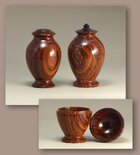
Zillions of tops and bottle stoppers.
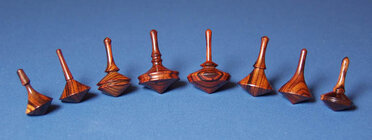
Back when Fidget Spinners were the craze - Cocobolo, Ebony, and brass.
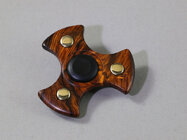
Here’s a Cocobolo magic wand blank ready to turn.
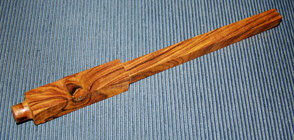
And a bunch more, jewelry, hairsticks, little vases. People love things made from it.
Note that not all Cocobolo has the brilliant color. I have some pieces that are boring.
One more thing about Cocobolo - it burns extremely well! Light a thin piece with a match and it’s so full of resins, oils, or something it burns like a candle.
JKJ
Last edited:
Interesting John! I have a piece of Cocobolo BURL, which is pretty much unheard of and unbelievably rare. I do agree it does have a spicy smell, and the color changes from the reds and violets to browns and darker black with age. I have one piece that is old growth from the 70's and it is very dark!It’s also a quite heavy wood. Polishes nicely by just buffing. I love working with it. A long time ago I got a number of pieces of outstandingly beautiful wood for a song, for about $50 I got what would probably cost $1200 today. A couple were so big I had trouble lifting and carrying them. I had no idea what it was and the seller had it labeled as Claro Walnut from California. I figured out what it was much later when I got interested in wood ID with a microscope.
I cut the big pieces into small pieces and turn small things. I wear a mask and wash my skin after turning/sanding/scraping.
Lidded boxes, Cocobolo and Ebony.
I caught a grief from some self-appointed “Woodturning Police” on one forum for making pieces with unsantioned lid/base ratios.
Ha! I was offered $400 for one. I gave it to the mother of a baby girl instead.
View attachment 74682
Zillions of tops and bottle stoppers.
View attachment 74683
Back when Fidget Spinners were the craze - Cocobolo, Ebony, and brass.
View attachment 74684
Here’s a Cocobolo magic wand blank ready to turn.
View attachment 74685
And a bunch more, jewelry, hairsticks, little vases. People love things made from it.
Note that not all Cocobolo has the brilliant color. I have some pieces that are boring.
One more thing about Cocobolo - it burns extremely well! Light a thin piece with a match and it’s so full of resins, oils, or something it burns like a candle.
JKJ
Is there anything one can use as a finish to slow the darkening of cocobolo, to reduce the photosensitivity?
the color changes from the reds and violets to browns and darker black with age
Is there anything one can use as a finish to slow the darkening of cocobolo, to reduce the photosensitivity?
Two things: when cutting blanks from some very old cocobolo pieces maybe 5”x7” in cross section, I noticed darkening around the outer surface, like it was slowly seeping into the wood! It had to be more than light, so I suspected it due to oxidation. I sometimes put shellac on small things from cocobolo (Mylands Friction Polish on finger tops and such) and keep them in a display cabinet in the shop office. the one box I kept, for example, doesn’t look any darker now than when I took the photo.
I also did a test once with Purpleheart: several pieces cut from the same board, each treated differently. The piece I had unfinished sitting on the shelf in a normally dark garage shop turned brown everywhere except for the surface against the shelf. A piece put in the sun turned brown quickly. This casual, non-scientific suggests that both the UV in light and oxidation may play a part. Chemical reactions may also turn wood dark, such as the Cocobolo I mentioned quickly turning almost black after applying Watco danish oil.
I tried asking Sir Google and got various answers, including this technical-sounding comment on a botany forum:
“… caused by the polymerization of polyphenols from lignin into tannins which are dark red or brown in color when they are highly polymerized.”
One thing to remember is the somewhat exaggerated comment I heard decades ago: in 100 years all wood will be black! True or not, for woodturning, to me it reinforces the importance of form and surface over wood color, grain, and figure!
This brings to mind the old woodturner’s insult: when someone proudly shows off a piece with poor form, turning, and surface, just say “My, what pretty wood!”. Due to that, unless specifically asked for an honest critique, I make a point of never saying that unless as a postscript if the piece is turned beautifully as well - instead point out the positive aspects of the piece (there are always some).
JKJ
Last edited:
The wood doesn’t look like Cocobolo to me. If interested, shave the end grain of a small piece containing a few rings with a single-edged razor blade and examine it with a 10x magnifier or microscope. The pores are generally filled with an orange resin. Compare to photos on the Wood Database and elsewhere. Also, the heartwood extractive are water soluble and will fluoresce under blacklight (I use 365nm UV and flashlights.)
JKJ
JKJ
I am pretty sure that it is Honduras Rosewood (Dalbergia stevensonii) I have used this wood a lot and am pretty sure with the way the grain looks.Looks quite good just with sanding - pretty sure it is cocobolo, but any ‘spicy’ odor is either minimal or my Spring allergies and PAPR use make it less noticeable.
View attachment 74690
Well, no spicy scent so not cocobolo.
Maybe Kingwood?
Did you put water on it before the blacklight? Needed to see the fluorescence.
End grain examination can really narrow down the candidates, especially by eliminating some.
This may be interesting if you suspect it is some type of rosewood:
Distinguishing Brazilian Rosewood, East Indian and Other Rosewoods | The Wood Database
As for the looking at the side grain, take a look at potential candidates at the hobbithouseinc.com website, Wood Pics section. This is the best I’ve seen to show the incredible variation even within one species, making it nearly impossible to be SURE, if that’s important. Select the page for a candidate species and scroll down the page for photos of end grain and side grain of boards. There is much overlap from photos, a careful examination of can narrow things down.
I forgot if I mentioned it in this thread but the Wood Identification article on the Wood Database can help a lot, in particular, section 7. And note the Still Stumped section near the bottom - the gov will ID wood for free.
Wood Identification Guide | The Wood Database
Or just do what most people do: pick a possible wood name and go with it. Almost nobody will question it!
JKJ
Progress is going slowly, but the ballet wig stand is taking shape...It's in progress, but technically no longer on the lathe. I'm working through a wig stand with a ballerina theme. I've been experimenting with some multi-axis stuff inspired by some of Mark Sfirri's work in one of the recent AAW magazines. It's made of hard maple for what it's worth.View attachment 74335

